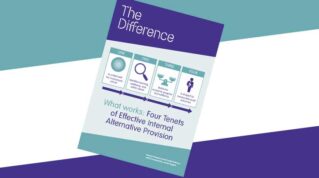In medicine, diagnosis and treatment are typically useful because those who decide upon them share an understanding of processes and terms. Even if they disagree, two doctors discussing the same patient draw on shared knowledge that makes it more likely they’ll find consensus on an intervention plan.
Not so in education, and this is causing chaos in our SEND system.
We can’t agree on which children common labels such as ‘cognition and learning’, ‘learning difficulty’, ’social, emotional and mental health’ and many others apply to. This makes it impossible to know if what happens because of these labels is of any use.
In turn, this means damaging pseudo-medical diagnostic and treatment procedures remain stubbornly resistant to our efforts to make education more evidence-informed.
For example, despite there being no evidence for such conditions, thousands of children continue to be identified with Meares-Irlen syndrome or visual stress and prescribed coloured paper and/or tinted lenses.
Similarly, as this week’s Schools Week investigation shows, EHCPs and documents like Pupil Passports often include adaptations and interventions for which there is no evidence of efficacy beyond placebo or Hawthorne effects.
These include fidget toys, wobble cushions, sensory tents and even learning styles, which have been debunked and driven out of education everywhere else.
A particularly worrying concern is that it appears those working in schools can’t trust the advice of those who input into EHCPs; many of the dubious suggestions explored in this investigation come from them. In the absence of robust evidence, they appear to often rely on little more than anecdote and personal experience.
The medicalised model on which diagnosis and intervention are based is also sustaining a belief – inside and outside of education – that children learn in different ways, that some just can’t make adequate progress unless they have very different provision to others.
Going on as we are comes with two huge costs
In most cases this just isn’t true, but the belief is causing much of the ire and antagonism between families and schools and putting great pressure on SEND departments and special schools.
The truth is that all children benefit from predictability, order, calm and carefully sequenced instruction with plenty of checking for understanding and adaptive teaching. But a plethora of the interventions children identified with SEND are subject to make these base conditions harder to create and embed.
This would be less of a problem if the labels and interventions were useful to those they were applied to. And perhaps some are, but lack of clarity around terms and grave weaknesses in review processes (where these exist) mean we have no real way of knowing.
Do movement breaks work? Social stories? Sensory circuits? Zones of regulation? If they do, what are the conditions required to make them successful?
We have absolutely no idea and the wide range of practice that sits beneath these terms means we couldn’t construct studies even if we wanted to.
Some will argue this doesn’t matter, that if people feel something helps them then that’s enough.
This is a weak argument. Experiences and outcomes for children exposed to the SEND system are dire; children, their families and professionals who work with them are by and large deeply unhappy with the status quo.
And it’s no surprise, because going on as we are comes with two huge costs.
The first is opportunity cost. Any child doing anything is not doing something else. If what they are doing is worse than what they could be doing, then we are harming their educational chances. Sadly, it is highly plausible that a SEND identification is doing just that by way of poorly conceived interventions – and this with some of our most vulnerable learners.
The second is financial cost. The entire system is creaking – whole councils facing bankruptcy – under the weight of SEND demand. This can only make things worse for all children, and experience tells us the most vulnerable pay the price first and hardest.
In short, the SEND white paper mooted this week must bring plans to improve EHCPs and bring some quality assurance to bear on the process – even if that’s not popular in the short term.












EHCPs should be quality assured of course but if the author thinks coloured paper, fidget toys, and wobble cushions are the problem with the send system they can’t have been talking to many parents. It seems a reach, to say the least, to describe any of these things as damaging pseudoscience.
What a load of absolute twaddle! Evidence base for movement breaks? Is there an Evidence base for your toilet breaks Mr Newmark? Maybe you don’t need them after all.
Yes, outcomes are dire but that’s not because of fiddle toys, for crying out loud. It’s because of lack of understanding, lack of flexibility and lack of resource. It’s fixed views like yours that don’t respond to individual needs or actually take proactive steps to address the very real barriers that many neurodivergent kids face just getting through the school day.
What a load of rubbish. If that is what school leaders think then no wonder so many SEN children fail in mainstream schools. The comment about learning styles of the most ridiculous thing I’ve ever read. In the real adult world it’s well known that people have different learning styles.
Are you an educational psychologist? Or a SEND parent, who is living the life where they can see and experience the massive difference to home life when a child no longer comes home from school utterly empty of the ability to cope due to a disabling environment combined with immense social pressure to confirm, at great personal cost? If not, the this article is, at best, poor quality fill and, at worst, damaging. Schools Week, please do better. Don’t publish opinions like this without input from educational psychologists or other real experts in the field. It’s ableist tripe.
The comment about light sensitivity, on which there is abundant evidence – see Wilkins, Visual Stress (OUP) – is perhaps complicated by the attempts to name it as a syndrome. The Institute of Optometry”s screening kit is an inexpensive initial check, and in one case I was involved in led to the identification of hydrocephalus. The issue requires further investigation, but is not to be lightly dismissed. John Bald FCCT.
I find it unsettling and potentially harmful that the article arguing the lack of evidence behind SEND interventions fails to reference any reliable and valid research to support its claim. Moreover, there is a substantial body of research demonstrating the efficacy and effectiveness of the SEND interventions mentioned in the article. For instance, Sensory Circuits have been supported by studies such as Baranek (2002), which highlights the effectiveness of sensory and motor interventions for children with autism (Journal of Autism and Developmental Disorders, 32, 397-422).
“Do movement breaks work? Social stories? Sensory circuits? Zones of regulation? If they do, what are the conditions required to make them successful?
We have absolutely no idea…”
Well, actually Ben, we do! A quick internet search or AI search brings up a plethora of scientific papers that prove these interventions help with regulation, which in turn aids learning. Your article speaks volumes about the lack of knowledge you possess on the subject. Furthermore, you write like the many other ‘professionals’ I have come across these past few years – mainstream schools are rife with complacency and local councils love playing the world’s smallest violin for their bankruptcy ‘woes.’ People often forget that us parents of SEN children, are also tax payers, who pay for a service we cannot get access too. We also pay for the local councils and schools, so we are in charge and we will fight to get what our children deserve.
I have diagnosed mearles irlens syndrome. I have diagnosed dyslexia too. I wear purple lenses which allow me to read, in this instance, twaddle like this. The lenses stop letters from floating above the page which understandably makes reading more difficult. My lenses were life changing as studying for my BA( hons) and nursing diploma were extremely difficult without them prior to diagnosis. I understand that people’s vision not all being the same is a difficult concept for you to understand as evidenced in this dangerously uniformed piece.